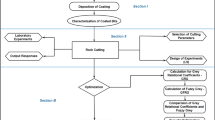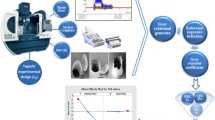Abstract
Bone drilling is frequently done during Orthopaedic surgery to produce hole for screw insertion to fix and immobilize the fractured bones. Minimally invasive drilling of bone has a great demand as it helps in better fixation and quick healing of the broken bones. In the present investigation, Taguchi methodology coupled with the fuzzy logic based on desirability function is used for the optimization of bone drilling process to minimize the drilling induced damage of bone. Experiments have been performed with different conditions of feed rate and spindle speed using full factorial design. The responses considered are temperature, force and surface roughness. The multiple responses are aggregated into a single multi-performance index using fuzzy based desirability function which is then optimized using the Taguchi method. The optimal setting and the influence of the bone drilling process parameters on the multi-performance index is determined using response table, response graph and analysis of variance. The confirmation experiment carried out to validate the results reveals that the present approach can effectively minimize the bone tissue damage during drilling.








Similar content being viewed by others
References
Adnan, M. R. H. M., Sarkheyli, A., Zain, A. M., & Haron, H. (2013). Fuzzy logic for modeling machining process: A review. Artificial Intelligence Review. doi:10.1007/s10462-012-9381-8.
Al-Refaie, A., Rawabdeh, I., Jalham, I., Bata, N., & Abu-Alhaj, R. (2013). Optimization of multiple responses in the Taguchi method using desirability function and fuzzy regression. In Proceedings of the international multiConference of engineers and computer scientists, vol. II, IMECS, March 13–15, 2013, Hong Kong.
Augustin, G., Davila, S., Mihoci, K., Udiljak, T., Vedrina, D. S., & Antabak, A. (2008). Thermal osteonecrosis and bone drilling parameters revisited. Archives of Orthopaedic and Trauma Surgery, 128, 71–77.
Bagawade, A. D., Ramdasi, P. G., Pawade, R. S., & Bramhankar, P. K. (2012). Machining optimization models for hard turning: A review. International Journal of Mechanical Engineering and Research, 1(1), 55–60.
Cardoso, P., & Davim, J. P. (2012). A brief review on micromachining of materials. Review of Advanced Materials Science, 30, 98–102.
Chang, P. C., Hsieh, J. C., & Liao, T. W. (2005). Evolving fuzzy rules for due date assignment problem in semiconductor manufacturing factory. Journal of Intelligent Manufacturing, 16(4–5), 549–557.
Datta, S., Bandyopadhyay, A., & Pal, P. K. (2008). Grey based Taguchi method for optimization of bead geometry in submerged arc bead-on-plate welding. International Journal of Advanced Manufacturing Technology, 39, 1136–1143.
Derringer, G., & Suich, R. (1980). Simultaneous optimization of several response variables. Journal of Quality Technology, 12(4), 214–219.
Fatima, A., & Mativenga, P. T. (2013). A review of tool-chip contact length models in machining and future direction for improvement. Proceedings of the Institution of Mechanical Engineers, Part B: Journal of Engineering Manufacture, 227(3), 345–356.
Güngör, Z., & Arıkan, F. (2007). Using fuzzy decision making system to improve quality-based investment. Journal of Intelligent Manufacturing, 18(2), 197–207.
Gururaja, S., Ramulu, M., & Pedersen, W. (2013). Machining of MMCs: A review. Machining Science and Technology, 17(1), 41–73.
Hsiao, Y. F., Tarng, Y. S., & Huang, W. J. (2007). Optimization of plasma arc welding parameters by using the Taguchi method with the grey relational analysis. Materials and Manufacturing Processes, 23(1), 51–58.
Jangra, K., Grover, S., & Aggarwal, A. (2012). Optimization of multi machining characteristics in WEDM of WC-5.3%Co composite using integrated approach of Taguchi, GRA and entropy method. Frontiers of Mechanical Engineering, 7(3), 288–299.
Kaladhar, M., Venkata Subbaiah, K., & Srinivasa Rao, C. H. (2012). Machining of austenitic stainless steels-a review. International Journal of Machining and Machinability of Materials, 12(1), 178–192.
Karaca, F., Aksakal, B., & Kom, M. (2011). Influence of orthopaedic drilling parameters on temperature and histopathology of bovine tibia: An in vitro study. Medical Engineering & Physics, 33(10), 1221–7.
Köklü, U. (2013). Optimisation of machining parameters in interrupted cylindrical grinding using the Grey-based Taguchi method. International Journal of Computer Integrated Manufacturing. doi:10.1080/0951192X.2012.749537.
Latha, B., & Senthilkumar, V. S. (2009). Analysis of thrust force in drilling glass fibre-reinforced plastic composites using fuzzy logic. Materials and Manufacturing processes, 24(4), 509–516.
Latha, B., & Senthilkumar, V. S. (2010). Modeling and analysis of surface roughness parameters in drilling GFRP composites using fuzzy logic. Materials and Manufacturing Processes, 25(8), 817–827.
Lee, J., Ozdoganlar, O. B., & Rabin, Y. (2012). An experimental investigation on thermal exposure during bone drilling. Medical Engineering & Physics, 34(10), 1510–1520.
Lu, D., & Antony, J. (2002). Optimization of multiple responses using a fuzzy-rule based inference system. International Journal of Production Research, 40(7), 1613–1625.
Pandey, R. K., & Panda, S. S. (2013). Drilling of bone: A comprehensive review. Journal of Clinical Orthopaedics and Trauma. doi:10.1016/j.jcot.2013.01.002.
Pandey, R. K., & Panda, S. S. (2013a). Modeling of temperature in orthopaedic drilling using fuzzy logic. Applied Mechanics and Materials, 249–250, 1313.
Roy, R. (2001). Design of experiments using the Taguchi approach: 16 steps to product and process improvement. New York: Wiley. ISBN 0471361011.
Sait, A. N., Aravindan, S., & Haq, A. N. (2009). Optimisation of machining parameters of glass-fibre-reinforced plastic (GFRP) pipes by desirability function analysis using Taguchi technique. The International Journal of Advanced Manufacturing Technology, 43, 581–589.
Singh, A., Datta, S., Mahapatra, S. S., Singha, T., & Majumdar, G. (2013). Optimization of bead geometry of submerged arc weld using fuzzy based desirability function approach. Journal of Intelligent Manufacturing, 24, 35–44.
Siriyala, R., Alluru, G. K., Penmetsa, R. M. R., & Duraiselvam, M. (2012). Application of grey-taguchi method for optimization of dry sliding wear properties of aluminum MMCs. Frontiers of Mechanical Engineering, 7(3), 279–287.
Tzeng, Y. F., & Chen, F. C. (2007). Multi-objective optimization of high-speed electrical discharge machining process using a Taguchi fuzzy-based approach. Materials and Design, 28, 1159–1168.
Yager, R. R., & Filev, D. P. (1999). Essential of fuzzy modeling and control. New York: Willey.
Yildiz, A. R. (2008). Hybrid Taguchi-Harmony search algorithm for solving engineering optimization problems. International Journal of Industrial Engineering, 13(5), 286–293.
Yildiz, A. R. (2009). A new design optimization framework based on immune algorithm and Taguchi’s method. Computers in Industry, 60, 613–620.
Yildiz, A. R. (2012). A comparative study of population-based optimization algorithms for turning operations. Information Sciences, 210, 81–88.
Yildiz, A. R. (2013). Hybrid Taguchi-differential evolution algorithm for optimization of multi-pass turning operations. Applied Soft Computing, 13, 1433–1439.
Yusup, N., Zain, A. M., & Hashim, S. Z. M. (2012). Evolutionary techniques in optimizing machining parameters: Review and recent applications (2007–2011). Expert Systems with Applications, 39, 9909–9927.
Zadeh, L. A. (1976). Fuzzy-algorithm approach to the definition of complex or imprecise concept. International Journal of Man-Machines Studies, 8(123), 249–291.
Author information
Authors and Affiliations
Corresponding author
Rights and permissions
About this article
Cite this article
Pandey, R.K., Panda, S.S. Optimization of bone drilling using Taguchi methodology coupled with fuzzy based desirability function approach. J Intell Manuf 26, 1121–1129 (2015). https://doi.org/10.1007/s10845-013-0844-9
Received:
Accepted:
Published:
Issue Date:
DOI: https://doi.org/10.1007/s10845-013-0844-9




